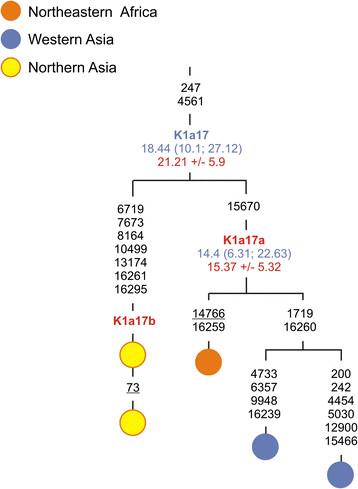Source - http://dienekes.blogspot.fr/
The eastern European mtDNA discussed in this article might be a remnant of the population of Proto-Europeoids that occupied Siberia even in Upper Paleolithic times (as the genome of the Mal'ta Upper Paleolithic Siberian has shown). However, the authors write:
Overall, the phylogeographic analysis strongly implies that the western Eurasian founders, giving rise to Siberian specific subclades, trace their ancestry only to the early and mid-Holocene, though some of genetic lineages may trace their ancestry back to the end of LGM. Importantly, we have not found the modern northern Asians to have western Eurasian genetic components of sufficient antiquity to indicate traces of pre-LGM expansions, that originated from the Upper Paleolithic industries present both in the southern Siberia and Siberian Arctic, and that date back to ~30 kya, well before the LGM [43]–[45].
If this is true, then probably the mysterious Mal'ta-like population did not have a lasting impact in Siberia.
The western Asia/Caucasus migration can't be attributed to farming expansions (because Siberia didn't have those), so it may very well be a genetic signature of the Bronze Age expansion of Indo-European languages (assuming it did not go there with occasional trade and intermarriage with later Eastern Europeans and Central Asians).
BMC Evolutionary Biology 2014, 14:217 doi:10.1186/s12862-014-0217-9
Western Eurasian ancestry in modern Siberians based on mitogenomic data
Miroslava Derenko et al.

Phylogenetic tree of haplogroup K1a17. Numbers along links refer to substitutions scored relative to rCRS [47], back mutation is underlined. Time estimates (in kya) shown along links next to clade labels are based on the complete mtDNA genome clock (given with 95% CI and marked in blue) and the coding region clock (given with the associated standard error and marked in red). Redefined haplogroup label is shown in blue; red are newly identified haplogroups in the present study. Derenko et al. BMC Evolutionary Biology 2014 14:217 doi:10.1186/s12862-014-0217-9
Abstract
Background
Although the genetic heritage of aboriginal Siberians is mostly of eastern Asian ancestry, a substantial western Eurasian component is observed in the majority of northern Asian populations. Traces of at least two migrations into southern Siberia, one from eastern Europe and the other from western Asia/the Caucasus have been detected previously in mitochondrial gene pools of modern Siberians.
Results
We report here 166 new complete mitochondrial DNA (mtDNA) sequences that allow us to expand and re-analyze the available data sets of western Eurasian lineages found in northern Asian populations, define the phylogenetic status of Siberian-specific subclades and search for links between mtDNA haplotypes/subclades and events of human migrations. From a survey of 158 western Eurasian mtDNA genomes found in Siberia we estimate that nearly 40% of them most likely have western Asian and another 29% European ancestry. It is striking that 65 of northern Asian mitogenomes, i.e. ~41%, fall into 19 branches and subclades which can be considered as Siberian-specific being found so far only in Siberian populations. From the coalescence analysis it is evident that the sequence divergence of Siberian-specific subclades was relatively small, corresponding to only 0.6-9.5 kya (using the complete mtDNA rate) and 1–6 kya (coding region rate).
Conclusions
The phylogeographic analysis implies that the western Eurasian founders, giving rise to Siberian specific subclades, may trace their ancestry only to the early and mid-Holocene, though some of genetic lineages may trace their ancestry back to the end of Last Glacial Maximum (LGM). We have not found the modern northern Asians to have western Eurasian genetic components of sufficient antiquity to indicate traces of pre-LGM expansions.